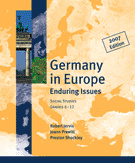Topic 1: Germany’s Changing Position in Europe and the World

 | Focus Question #1 |
and to the United States?
- What are the reasons for studying Germany?
- How does Germany compare to the United States and the rest of Europe in land size, GDP, and relative population?
- What is the significance of the location of Germany?
Alignment to National Standards
Background Information
A working knowledge of the relative location and size of the nations of Europe is an important component in understanding the political and economic relationships among these countries. Germany is geographically located in the center of Europe with political, economic, and social windows that open East and West.
Even though the nations of Europe share a common geographic location, many significant differences exist, such as availability of natural resources, population concerns, and economic pressures. These factors play a role in influencing the political relationships of these nations.
In addition, an understanding of the central role Germany played in the establishment of the European Union is fundamental to student understanding of the growing alliance on the continent
Essential Content
Note: The following words/concepts are essential to an understanding of this lesson. Put the words on your Word Wall and use them in context as you teach the lesson.
|
|

 Printable PDF
Printable PDF